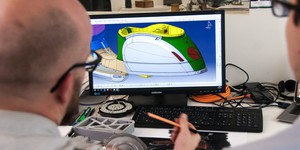Abstract
Many medicines come in bottles with special child-proof caps so that small children can't accidentally open the bottle and eat the pills. To a small child who can't read the label, the pills might look just like candy. What cues do we use to tell the difference between medicine and candy? At what age can we tell them apart? This project can show you how to find out.Summary
Andrew Olson, Ph.D., Science Buddies
Sources
This project is based on:
- Sisk, R.R., 2004. Candy or Medicine? Children May Be Confused, California State Science Fair Abstract. Retrieved July 26, 2006.
Objective
The goal of this project is to determine if young children are able to tell the difference between candy and medicine.
Introduction
Many medicines are in the form of colorful tablets, pills, or even chewable gels. To a small child (or perhaps even an adult), they might appear like candy, especially out of the medicine bottle. What cues do we use to tell the difference between medicine and candy? Can small children tell them apart?
Keeping medicine out of reach of small children is one way to protect them from a potential hazard. Here are some additional tips on poison prevention related to medicine and small children from the Oklahoma Poison Control Center (Staff, 2005):
- Never refer to medicine as candy. Doing so could create the perception that it is harmless.
- Since children also mimic adults, avoid taking medications in front of them. Vitamins, particularly those containing iron, can be poisonous if taken in large doses.
- Beware of certain cosmetics and personal products. In addition to medicines, children may be tempted to taste cosmetics and personal-care products. Store items such as aftershave, cologne, perfume, hair spray, shampoo, and fingernail polish remover out of reach.
- Keep products in original containers. Never put them in anything else, where they could be mistaken for something harmless.
- Ask for and buy child-resistant packaging. Child-resistant caps do not guarantee children cannot open them, but can slow them down.
To do this project, you will have to survey a random sample of small children to see if they can tell the difference between selected medicines and candies. You will need to have written permission from the children's parents before conducting the study. The Experimental Procedure section explains how to construct the survey. The Science Buddies resource, How Many Survey Participants Do I Need?, will show you how to figure out how many respondents you need to recruit in order to achieve your desired level of confidence that your results are representative of the total population.
Terms and Concepts
To do this project, you should do research that enables you to understand the following terms and concepts:
- population,
- random sample.
Questions
- How many participants do you need in your study in order to be 90% confident that the results from your study are representative of 4–6 year-olds in general? How many participants for a 95% confidence level?
Bibliography
- ESN, 2005. The End of the Age of Bitter Pills, European Sensory Network. Retrieved July 26, 2006.
- Staff, n.d. Medication Safety, Oklahoma Poison Control Center. Retrieved April 14, 2018.
Materials and Equipment
To do this experiment you will need the following materials and equipment:
- sample over-the-counter medicines,
- sample candies,
- varnish or shellac,
- glue,
- index cards,
- lab notebook,
- graph paper,
- children between the ages of 4 and 6 (written parental consent must be obtained).
Experimental Procedure
Note: There are special considerations when designing an experiment involving human subjects. For an experiment such as this, which involves children, parental consent must be obtained for all participants prior to beginning the experiment. In addition, the experimental design must be approved by the fair's scientific review committee (SRC) prior to the commencement of experiments or surveys. Please refer to the ISEF rules for additional important requirements for studies involving human subjects: https://www.sciencebuddies.org/science-fair-projects/competitions/human-subjects-regulations.
- You will need to plan well ahead for this experiment in order to obtain scientific review board approval and parental consent forms for your survey participants. The scientific review board will need a detailed description of your proposed experimental procedure. They will also need to approve the parental consent forms before you begin.
- With help from your parents or a pharmacist, examine over-the-counter medicines available in a local drug store. What are the typical shapes, sizes and colors used for medicine? Which ones do you think would be most easily confused with candy? Which ones do you think would be least likely to be confused with candy? Make selections (e.g., up to 10) for use in the study. Try to include both kinds of medicines (easily confused with candy, unlikely to be confused with candy).
- Select an equal number of candies for use in the study. Again, try to include both those that could easily be confused with medicine, and those that you think are unlikely to be confused with medicine.
- Prepare a sample of each medicine and candy for test presentation by varnishing the surface, and then gluing a single piece to the center of a blank index card. Identify the medicine or candy lightly on the back of the card in pencil. Make sure that the writing does not show through the front of the card. Or better yet, number the cards, and make a table in your lab notebook to identify the contents of each card.
- Get permission from parents of Kindergarten students to participate in study. You will also need to get permission from the teacher of each Kindergarten class.
- In the classroom with teacher present, perform the test with each child individually. Hold up each card and ask, "Is this candy or medicine?"
- Record the answer for each card.
- Tally the results for each sample and record on a graph.
- How many medicines were mistaken for candy?
- How many candies were mistaken for medicine?
- How confident can you be that your results would be the same if you surveyed all of the Kindergarteners in your state?
Ask an Expert
Global Connections
The United Nations Sustainable Development Goals (UNSDGs) are a blueprint to achieve a better and more sustainable future for all.
Variations
- In this experiment you have removed many of the clues (e.g., packaging) that an adult would use to tell medicine apart from candy. Do you think candy confusion would be a problem for other age groups? Expand the study to include older age groups. How do the results from older children, teenagers, and/or adults compare?
- Small children can't swallow pills whole with water, like older children and adults. Oral drug formulations for small children are made as liquids, chewable tablets, and gels. Some are even available in the form of "a melt-in-your-mouth 'candy' with appealing names and tastes such as 'Grape Punch', 'Wacky Watermelon', and 'Bubblegum Burst', packaged in eye-catching bright cherry-red. The results: increased sales." (ESN, 2005) Design an experiment to test whether packaged medicines like these can be mistaken for candy.
Careers
If you like this project, you might enjoy exploring these related careers:










